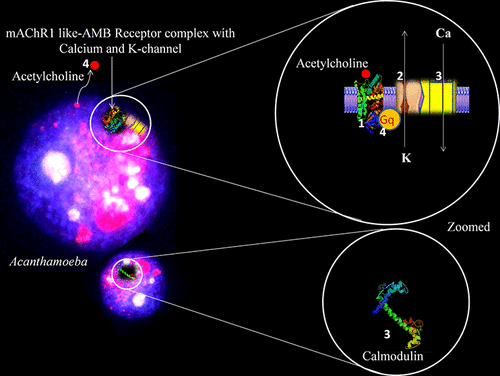当前位置:
X-MOL 学术
›
ACS Chem. Neurosci.
›
论文详情
Our official English website, www.x-mol.net, welcomes your
feedback! (Note: you will need to create a separate account there.)
Drug Target Discovery Methods In Targeting Neurotropic Parasitic Amoebae
ACS Chemical Neuroscience ( IF 4.1 ) Pub Date : 2017-12-29 00:00:00 , DOI: 10.1021/acschemneuro.7b00492 Abdul Mannan Baig 1 , Nuzair Waliani 2 , Saiqa Karim 2
ACS Chemical Neuroscience ( IF 4.1 ) Pub Date : 2017-12-29 00:00:00 , DOI: 10.1021/acschemneuro.7b00492 Abdul Mannan Baig 1 , Nuzair Waliani 2 , Saiqa Karim 2
Affiliation

|
Neurotropic parasitic amoebal infections have imposed an enormous challenge to chemotherapy in patients who fall victims to the infections caused by them. Conventional antibiotics that are given to treat these infections have a low patient compliance because of the serious adverse effects that are associated with their use. Additionally, the growing incidence of the development of drug resistance by the neurotropic parasites like Naegleria fowleri, Balamuthia mandrillaris, and Acanthamoeba spp has made the drug therapy more challenging. Recent studies have reported some cellular targets in the neurotropic parasitic Acanthamoeba that are used as receptors by human neurotransmitters like acetylcholine. This Viewpoint attempts to highlight the novel methodologies that use drug assays and structural modeling to uncover cellular targets of diverse groups of drugs and the safety issues of the drugs proposed for their use in brain infections caused by the neurotropic parasitic amoebae.
中文翻译:

靶向神经嗜性变形虫的药物靶标发现方法
嗜神经性寄生虫变形虫感染已使化疗患者遭受化疗所带来的巨大挑战。由于与使用它们相关的严重不良反应,用于治疗这些感染的常规抗生素对患者的依从性较低。另外,诸如嗜酸奈格尔菌(Naegleria fowleri),曼巴拉瑞斯Bal虫(Balamuthia mandrillaris)和棘阿米巴棘壳虫(Acanthamoeba spp)等神经性寄生虫对药物产生抗药性的事件越来越多,这使药物治疗更具挑战性。最近的研究报道了神经质寄生棘阿米巴中的一些细胞靶标被人类神经递质(如乙酰胆碱)用作受体。该观点试图强调使用药物测定和结构模型来揭示各种药物的细胞靶标的新方法,以及提出的将其用于由嗜神经性寄生虫变形虫引起的脑部感染的药物安全性问题。
更新日期:2017-12-29
中文翻译:

靶向神经嗜性变形虫的药物靶标发现方法
嗜神经性寄生虫变形虫感染已使化疗患者遭受化疗所带来的巨大挑战。由于与使用它们相关的严重不良反应,用于治疗这些感染的常规抗生素对患者的依从性较低。另外,诸如嗜酸奈格尔菌(Naegleria fowleri),曼巴拉瑞斯Bal虫(Balamuthia mandrillaris)和棘阿米巴棘壳虫(Acanthamoeba spp)等神经性寄生虫对药物产生抗药性的事件越来越多,这使药物治疗更具挑战性。最近的研究报道了神经质寄生棘阿米巴中的一些细胞靶标被人类神经递质(如乙酰胆碱)用作受体。该观点试图强调使用药物测定和结构模型来揭示各种药物的细胞靶标的新方法,以及提出的将其用于由嗜神经性寄生虫变形虫引起的脑部感染的药物安全性问题。











































 京公网安备 11010802027423号
京公网安备 11010802027423号